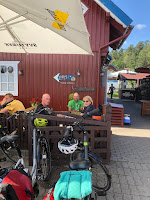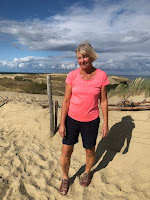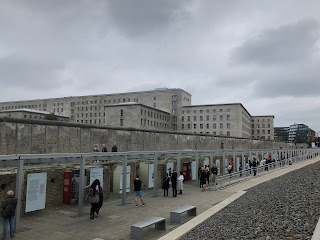When cycling the Curonian Spit a couple of years ago, I was overwhelmed with its beauty. An ecologically-sensitive area, protected by UNESCO, the Spit’s 98 kilometers long, covered in shifting sand dunes and home to many migrating birds. The Spit, a finger of land extending between the Baltic Sea and the Curonian Lagoon, is politically divided between Lithuania and Russia, and steeped in history.
I’d been eager to visit Thomas Mann’s family beach house. The pretty blue cottage has been well maintained over the years. Located in Nida, on the Lithuanian side, it’s shifted, like the sand, from summer family retreat, to convalescent centre for Goring’s elite Luftwaffe officers, to a writing centre/museum for current visitors. |
| Cycling break in Preila |
 |
| On sand dune near Preila |
The couple, now fleeing for their lives, planned to escape Hitler’s grasp via boat for Sweden the next morning. Instead, they were greeted by the Gestapo.Taken back to Berlin, to the cellar of Gestapo headquarters at Prinz-Albrecht Strasse 8, they were tortured, tried and executed in quick order. Arvid hung in December and Mildred was decapitated in February, 1943. I toured the Gestapo headquarters' site, now a memorial and outdoor museum, after I ended my bike tour, unwittingly following in Mildred's footsteps.
 |
| Former Gestapo headquarters in Berlin |
Mildred’s story is all the more engrossing because she was an American and because the consequences of her heroic efforts were smudged away. Why? Because being anti-fascist in Berlin during those years meant being pro-Soviet. Once the Nazis were defeated, the Americans considered anyone pro-Soviet an enemy. Former Nazis were treated better by the western media than pro Communists during the Cold War era.
February is a good month to remember brave women like Sophie Scholl, Mildred Harnack (and many others, shared via photographs from Gestapo files in the Donner book), who died that February, 1943. It was a month when the colour red was of blood not of hearts, when it was hate, not love, that seeped into everything. Sophie and Mildred deserve our best efforts to never take freedom and peace for granted. Could I die for a cause? I’m grateful not to be tested.
All the Frequent Troubles of our Days, a gripping biography written in an engaging, accessible style with short chapters and many photographs. I highly recommend it to readers interested in World War Two history.



No comments:
Post a Comment